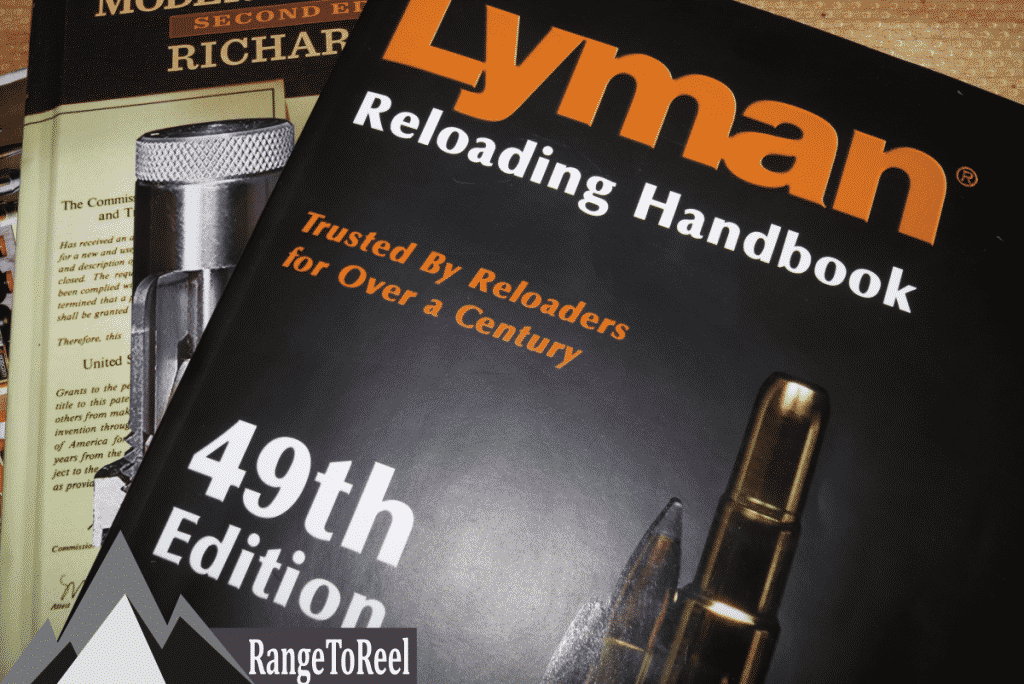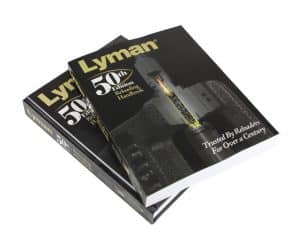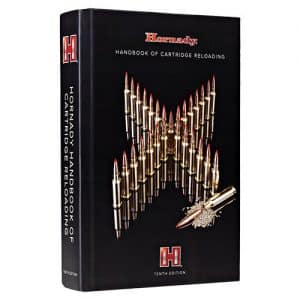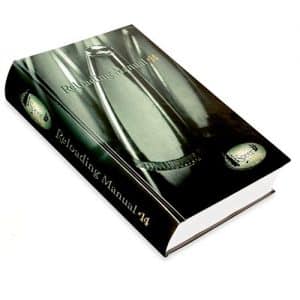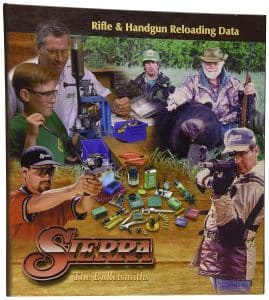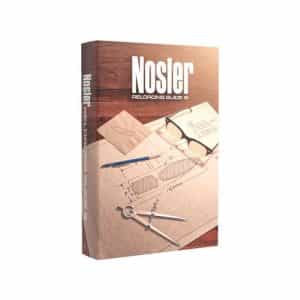Every reloader gets overwhelmed when first entering into the hobby. There’s a wide world of information that needs to be absorbed before you can even make your first bullet. Before getting into the reloading hobby you need to buy at least one quality reloading manual.
Why Do I Need A Reloading Manual?
I used to work retail in a local sporting goods store back when I was going through college. Almost every day somebody would ask if they actually needed a reloading manual.
My father taught me how to reload as a child. I used to sit and watch him reload for hours desperately waiting for a chance to try out the loads. Over time he helped me work up loads and slowly taught me the tools of the trade.
Honestly, it never occurred to me that the average person has never even opened up a reloading manual and they definitely don’t know how to use one. So what is a reloading manual actually used for?
- Teach You How to Reload: Every reloading manual that I own has a lengthy section on learning how to reload. If you’re an absolute beginner you should start off by checking out both the Lyman and Lee Manuals. You will have to refer to those manuals every time you reload for the rest of your life.
- Include Load Data: Nowadays most of us could learn how to reload by watching YouTube videos and reading forum posts, but that’s not why we need a reloading manual. The load data section is by far the most important section of your book. It has all the recipes you could possibly need to reload any caliber.
- Expected Velocity/Load Pressure: Don’t get into reloading if you get easily obsessed with hobbies. Once you get that itch you’ll be hooked for good. I’m constantly running my rifles through a chronograph and trying to fine-tune my reloads.
Why Are There So Many Editions?
Every year manufacturers come out with newer/better ammo. That’s why every couple of years manufacturers try to update the load data found in their books.
Personally, I wouldn’t buy every new edition that comes out. There’s just not that much change in the general-purpose ammo I make. Competitive shooters are the only people that really need to buy every new edition and that might even be overkill.
This is a hobby that’s been around for decades and very little has changed. If anything, reloading has gotten easier through the years thanks to the internet. I can remember when I had to call my local gun store and have them order powder so I knew it would be in stock. Nowadays you can order it online without having to worry.
What Should I Look For in a Reloading Manual?
By far the most important thing to look for is a wide variety of load data. Thanks to the internet you can get by with a beginner section that’s lacking, but load data is like having a fat stack of cash in the bank. You might never actually need to use it, but boy is it helpful when you do.
Your manual should have a wide range of reloading data for all calibers and bullet types. You will eventually find the need to acquire a few extra reloading manuals to fill voids caused by missing components. Keep an eye out for manuals that have special sections that match your reloading style.
Which is The Best Reloading Manual?
Lyman 50th Edition Reloading Handbook Softcover
Check Price: Amazon
Ask anybody what their favorite reloading manual is and they’ll problablly tell you Lyman. Throughout the years I’ve seen this manual recommended over and over.
From entry level reloaders to people who have been reloading for decades everybody loves the Lyman Reloading Manual. They’ve made 50 different editions so it must have something going for it. Why does everybody love the Lyman Reloading Manual?
The most important thing about a reloading manual is that it has to be written for somebody without any prior knowledge of the topic. With this manual it will teach you everything from setting up your dies, inspecting rounds to double-checking your powder charge. They take a hands on approach to teaching everything a new reloader needs to learn.
Lyman goes above and beyond when publishing their reloading data. They are one of the few publishers that really goes into depth about the intricacies of their loads. Of all the reloading books on this list they are the only one that lists load pressures.
They have a ton of reloading data on just about any bullet style you can imagine. I’ve tried a wide range of their recipes and everyone I’ve tried has been spot on. As with any hobby I do a little tinkering here and there to the formula, but they offer a great starting point.
Lyman is one of the only books that offer data on lead cast bullets. I don’t know if it’s because of the varying techniques found in the lead bullet manufacturing community or what, but nobody seems to offer data on lead cast ammo.
There’s data on every single Lyman casting mold ever produced. So if you ever plan on casting your own bullets this is the guide for you. Considering the low cost of cast lead bullets I spend a lot of time plinking around with lead.
It just gives you a broad range of information to cover every angle of approach. New loaders, old loaders, concealed carriers and professional marksmen will all find relevant info in this book. You just need to figure what applies to your situation and work from there.
If you’re really into the technical aspects of reloading you’ll love how accurate all the data is. Some manuals that I’ve seen are optimistic about their load data almost to the point where it seems like they’ve made it up. With Lyman my loads almost always match up perfectly when ran through the chronograph.
By far the biggest reason why I love the Lyman Manual is that they don’t make their own bullets. Every other reloading book I’ve used favors their own bullets over every other manufacturers. With Lyman you get an honest representation of a wide variety of different ammo manufacturers.
The overall breadth of information this book covers is impressive. The Lyman Reloading Handbook might now teach you everything that you need to know, but it teaches you enough to find the remaining information on your own.
Just remember that there isn’t a single book that can offer load data on every single bullet on the market and not everything will be accurate. That’s why I have a wide range of reloading books so I can double-check loads through multiple sources. If a load doesn’t look right when comparing to similar rounds you need to check another source.
If you could only have one reloading manual this is the one to buy. You get an expertly written book that’s loaded with information.
Lee Precision Modern Reloading Second Edition
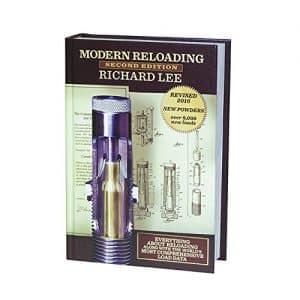
Check Price: Amazon
This is one of the newer reloading manuals in my library, but I wish I found it earlier. It was included with a Lee Classic Cast Press that I found at a flea market.
If you’ve looked into buying your first reloading press I’m sure you’ve seen all the Lee Beginner Reloading Kits on Amazon. This is the book that comes with all of these kits.
Since it’s included with all of the beginner kits the book really targets the absolute beginner. It has in-depth chapters on all the intricacies of reloading.
You learn everything from terms, how to use different tools, choosing between powders, setting up all your dies and everything else you could possibly need to know. If you’re just getting into the hobby it’s a great starting point since it offers step by step instructions to get you started.
Richard Lee is the same man who started the company behind Lee Reloading Equipment which causes a few problems for me. The beginning of this book works as one giant continuous sales pitch for Lee products which is great for anybody that owns a Lee press, but annoying for everybody else. It’s not a big deal since I don’t have to refer to those chapters anymore, but reading through did start to get on my nerves.
If you ignore the blatant bias for Lee gear you will find a ton of great reloading data and information. Even if you’re an experienced reloader go back through the introductory chapters and read them over. With 720 pages packed full of information, I guarantee you’ll learn something new.
Out of all the reloading manuals Lee’s book has one of the most thorough how-to sections. Even though a lot of this section is self-promotion of Lee products almost all of the information can be applied to other brands of reloading equipment.
You will also find in-depth chapters on topics I’ve never come across in other reloading manuals. One of the more interesting topics discussed, is the varying degrees of brass preparation and how it will affect future accuracy.
They also have a very thorough section dedicated to bullet casting which isn’t found in other books. However, I do prefer the actual load data for lead cast reloads found in the Lyman Manual. You also have a nice section on copper-plated bullet recipes.
When first reading through this book I was a little disappointed in the load data section. The section is thorough and offers data on lots of different loads, but it’s missing some of the finite details.
There’s data from every major powder manufacturers, but for some reason they chose not to include some of the more advanced metrics important to experienced reloaders. The load data section covers 167 cartridges with over 28 thousand different loads. There are a few notable cartridges missing but that’s why you need more than one reloading manual.
My biggest issue with the beginner reloader purchasing this book is that it requires you to recognize pressure signs in your bullets. The book only tells you the starting load and wants you to work up from there.
That’s great in theory since most loads work great around the starting load level, but it could get some reloaders in trouble. Beginners just don’t have the reloading experience required to see signs of excess pressure. That being said, I can’t even remember the last time I came close to reaching the max load data found in other books.
This really is a great reloading manual for both beginners and people who own Lee equipment. For advanced reloaders Lyman offers more load data at a comparable price.
Hornady Handbook 10Th Edition
Check Price: Amazon
When I first started reloading I overlooked the Hornady Handbook. I was uncertain of the value of this book since I thought it would be nothing but Hornady Bullets.
I didn’t get around to buying this manual until after I purchased my Hornady Lock n Load AP Press. I picked up the press a few days after black friday and the manual came as a free giveaway along with a range bag, headphones and a few other odds and ends.
Honestly, with Hornady being such a major player in the reloading industry I should have grabbed it earlier. After perusing for a while through the book I was pleasantly surprised.
This book is divided into two sections the theory of reloading and a compilation of load data. Honestly, I don’t think the section on the theory of reloading has been updated since the 70’s. Luckily, most of the information is still relevant, but some of the techniques are out of date.
The beginner’s how-to section was thorough and easy to read although most of the info wasn’t relevant to my needs. It had excellent info about the reloading process and a large section on all the safety steps that need to be followed. This section is a must-read for beginners and actually convinced me to buy a few products that I hadn’t heard of (damn them).
There are a few sections in the “Theory of Reloading” portion of this book that are way too advanced for beginners. Some of the sections were even confusing for me and I’ve been involved with the hobby for most of my life.
As somebody that buys lots of Hornady bullets, I should have bought this reloading manual sooner. If you typically reload using Hornady components than this is the book for you. It has reloading info for every single Hornady bullet currently on the market.
They use a wide variety of different powders with each of the bullets and each new edition adds more info to their index of load data.
Although I was a little disappointed with the information on expected pressures and accuracy of various loads I was pleasantly surprised by the accuracy of expected velocities. This is of course only for information relating to Hornady’s bullets, but it will still give you a rough guideline when developing similar loads from other manufacturers.
Speer Reloading Manual Number
Check Price: Amazon
Speer Ammunition recently announced the release of its 15th edition reloading manual. Since this is one of the newest reloading manuals on the market it offers comprehensive data on almost every powder currently available.
It offers a huge selection of different cartridges with a wide range of powder info. They even went back through their catalog and expanded data on previous calibers using all-new powders.
Since this book is so new it’s currently one of the only manuals on the market to include data on some of today’s most popular rounds. The only problem is that it only includes data when using speer bullets.
Once again you can take that data and work up similar loads using other manufacturers bullets, but there will be noticable differences between different bullet manufacturers.
Since this is another component-specific reloading manual its usefulness will vary from one person to the next. If you purchase speer components than this is the manual you need to purchase. It has lots of load data for Speer specific reloading components.
Personally, I’ve had better luck using Hornady components over Speer. So I don’t get a lot of use out of this reloading manual. That being said, I have used it to double-check loads and come up with a few loads that I couldn’t find elsewhere. It does have enough data to make this book well worth the price, although I wouldn’t choose it as my first reloading book.
The beginners guide and how to section offers all the same information found in the other reloading manuals. It’s lacking in a few sections, but overall it will get the job done.
If you’re new to reloading you would be much better off purchasing the Lyman reloading manual listed above. With all that being said this book has earned a place in my library. It has lots of components that I haven’t found in any other book.
Sierra Rifle & Handgun Reloading Manual
Sierra just came out with its sixth edition reloading manual and once again it’s a component-specific book. The Sierra bullet company has been making bullets for over 60 years. Sierra bullets might be expensive, but boy are they accurate.
Honestly, unless you reload a lot of sierra ammunition I’d probably skip this book. It’s longer than most of the other books on the market and it does include an extensive section on a wide variety of calibers, but they’re all Sierra specific.
If you shoot Sierra bullets it might make sense, but everybody else can find comparable data in the other books listed above. Maybe I’m just jaded because I hate the fact that the book comes in a binder.
Some people like the fact that they can take out individual pages for easy reference, but I’m not exactly organized. In the past, I’ve lost pages that I took out, accidentally torn frequently used pages and just caused a general mess in the book. However, there is one advantage. You can add easily add your own notes about loads right into the book for quick reference later.
Just like every other book on this list Sierra included a How-To section which is surprisingly thorough. It’s easy to read and includes just about every topic a beginner would need to know. This book is a great supplement, though I wouldn’t recommend it as the only book in your reloading library.
Nosler Reloading Guide
Check Price: Amazon
How many reloading manuals can one man have? I just need one more manual and I’ll be happy.
When I first bought the Nosler reloading manual I was really impressed. Unlike some of the other manuals on this list, the graphics and layout of this book made it easy to read. It doesn’t feel like a college level textbook like some of the other manuals.
I really liked reading through the beginner How-To section in this book. You should pay particular attention when they explain the different reasons why you should choose a certain bullet/powder. As a beginner it seemed like I was choosing my powders at random. It took forever to figure out the intricacies of developing a load.
This is another book that focus primarily on their own products. Even if you don’t you’re sure to get some information from their comprehensive list of powders.
I also love that they include a section on the most accurate powder and most accurate load. I have tried a lot of these recommendations and they are generally very accurate.
Although it isn’t really all that important for beginners, Nosler also includes a large section on energy charts and ballistics tables.
A Few Other Interesting Reloading Books
The Beginner’s Guide to Reloading Ammunition: With Space and Money Saving Tips for Apartment Dwellers and Those on a Budget
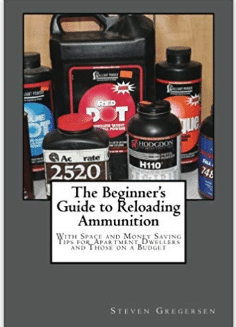
Check Price: Amazon
This book isn’t like all the other reloading manuals on this list. I don’t know if I would even call it a reloading manual since it doesn’t actually include load data.
Throughout the book, the author regularly notes that it’s designed for a beginner. At a fraction of the price of traditional reloading manuals it’s a great entry level book into the reloading hobby.
It’s designed for people who wish they could get into reloading, but have no idea where to start. It goes into great detail explaining about all the different gear and components needed for reloading.
The section on case preparation is surprisingly helpful in such an entry-level book. It lets you know about all those little tricks that can save you time/money without sacrificing quality and safety.
Most of the book focuses on handloading when you have limited resources. They talk about where you should save money and how to make room for all your gear in a small space. This section is a must-read for anybody that lives in an apartment.
The Practical Guide to Reloading Ammunition: Learn the easy way to reload your own rifle and pistol cartridges
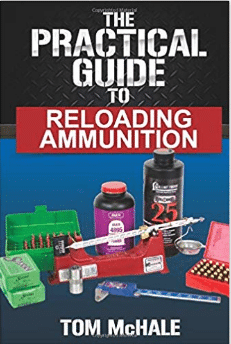
Check Price: Amazon
This is another beginners reloading book that doesn’t include any load data. It really simplifies some of the more confusing aspect of reloading. Chapter by chapter, this book walks you through all the basic components you need to get started.
Although you could piece together most of the information found in this book online or in regular reloading manuals I really love the layout. All of the most important reloading tips are presented in subheadings and bullets. The way everything is laid out makes it easy to page through the book and quickly figure out everything you need to know.
If a regular reloading manual was a bible this book would be more of a brochure. It has most of what you need to know to get started, but doesn’t really dive into the nitty-gritty.
Shooter’s Bible Guide To Handloading
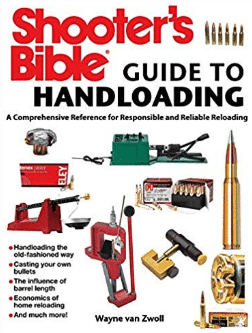
Check Price: Amazon
The shooter’s bible’s guide to handloading isn’t like most of the other reloading books on this list. It focuses on all the background information and the history of reloading.
Although this book was a great addition to my reloading library I can see why some readers are disappointed. The author focused more on the history of reloading than the actual process. There’s no way a beginner could actually learn how to reload after reading this.
It focuses more on the theory behind reloading. How different components affect your reloads and the economics behind choosing different components. FYI nobody ever saves money by learning how to reload. You just buy more gear and shoot more.
That being said, I was able to implement quite a few of these tricks on my own reloading workbench. This book wasn’t designed to answer every question. If that’s what you’re looking for purchase one of the reloading manuals listed above.
Lyman Cast Bullet Handbook
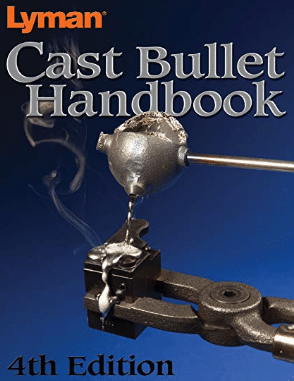
Lyman is the king of reloading cast bullets. They’ve been making lead molds since before I was born and they have the largest collection of lead cast load data on the market.
The Lyman reloading manual has all the best information on loading cast lead bullets. This book is the ultimate guide on learning how to both cast and reload lead ammunition.
When I first started casting my own bullets I had no idea where to start. I had a big old barrel of lead wheel weights and no idea what to do with them.
Thankfully, I ran across this book at my local library and it has everything you could possibly need to learn about casting and reloading lead bullets. Even if you don’t ever plan on casting your own bullets you should buy this book for the extensive load data.
A Few Things To Consider
There are two primary functions that manuals fill.
- Reloading manuals provide the basic steps of metallic cartridge reloading. A reloading manual combined with instructional videos will provide anyone with patience and time a chance to reload.
- Reloading manuals provide the basic load data(recipes) required for most of the common metallic cartridges. No manual will have the load data available for all loads and components.
Once you get past the beginning phase of reloading the main purpose of a reloading manual is to check load data. While you can find most load data online a reloading manual is important to second check peoples loads.
With some reloading powders there is a very fine line between what is an acceptable charge and whats downright dangerous. So you never know if the load data given online is at the top or bottom of the suggested weight. With a good reloading manual anyone with time and patience can learn how to reload.
Other Options for Reloading Data
Buying one of these reloading manuals is almost a necessity for the beginning reloader. Reloading manuals give you a great introduction to the reloading hobby at a relatively low price. You will learn both how to reload and the necessary components needed for each caliber. Though I would highly recommend you buy a reloading manual, at the very minimum the beginning reloader should borrow a manual from a friend or rent one from the library. If by some reason you can’t afford a traditional reloading manual there are a few alternative options you can consider.
You can get a load specific reloading manual. These reloading manuals are made for a each specific caliber. For the price I don’t know if I would consider these a great solution. I own a fair collection of these caliber specific loadbooks that I’ve found at my local flea market. These books offer a decent supplement to the traditional loadbooks but most of them haven’t been updated in a very long time. It’s important to check the load data found in these books with other references. Double checking load data is always a necessary step for reloaders.
Another option is to find caliber specific load data is online. A lot of people post load data on forums, but it’s not always a good idea to trust these recommendations. This is another resource that you should definitely double check your sources before trusting the information. It’s also impossible to determine how high the powder charge is with these posters. If someone recommends a maximum or minimum load you can quickly cause squibs or overpressure. I don’t recommend trusting anonymous posters on forums and you should use this method at your own risk.
Many of the powder and bullet manufacturers offer load data on their websites. Not only are these sites an excellent source of component specific information, they are generally safe and lab tested loads. If you are unable to find your specific load in a Reloading manual this should be the first place you look.
Which is The Best Reloading Manual
If you’re new to reloading you should definitely buy the Lyman Reloading Manual. The Lyman Reloading manual is going to offer the beginning reloader a good foundation to work with. Not only does it offer the fundamental aspects of reloading it gives you the largest variety of load data.
If you already own the Lyman reloading manual you should choose whichever reloading manual matches with your most frequently used components. The component specific reloading manuals are definitely excellent supplemental material to the Lyman Reloading manual.
If I could only have one reloading manual i would have to be Lymans newest edition. Lyman seems to have the largest variety of load data available. A lot of this comes down to personal preference since I like to cast my own bullets. Casting bullets is just another fun reloading hobby that’s available. It is difficult to find information on cast bullets and Lyman has the most information available on the subject. Any of these Reloading manuals combined with supplementary information on the internet should give you all the information needed to make good loads.

